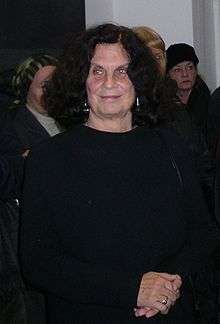Nuria Quevedo
Nuria Quevedo Teixidó (born 18 March 1938) is a Spanish painter and graphic artist, affiliated with the Communist Party, who has lived in Berlin since age 15.[1][2]
Nuria Quevedo | |
|---|---|
 | |
| Born | Nuria Quevedo Teixidó 18 March 1938 Barcelona, Spain |
| Nationality | Spanish, East German, German |
| Alma mater | East German Academy of Arts |
| Occupation | Painter, graphic artist |
| Political party | Communist |
| Awards | Goethe Prize of Berlin |
Biography
Nuria Quevedo's father, José Quevedo Fernández, was an aviator of the Spanish Republican Air Force. In 1939 he left Spain for France, along with her mother, but he soon returned to Barcelona, where he stayed until 1942. That year the whole family reunited, this time in Berlin, where her father worked for the Nazis. In 1945 mother and daughter moved to Barcelona, and in 1952 they returned to meet with their father in East Berlin, where they would settle permanently.[3]
In East Berlin Quevedo studied at the Higher School of Visual and Applied Arts in Weissensee, with Werner Klemke, Arno Mohr, and Klaus Wittkugel, later becoming a student at the East German Academy of Arts. She worked in a bookstore owned by the family.[3][4]
As a painter, she became well known in East Germany,[5] where she exhibited together with Equipo Crónica.[2][6]
Several of the artist's works have been sold at auction, including Teixidó Betrachtung des Fisches, sold at the Schmidt Art Auction's "Auction 42" in 2014.[1][2]
Quevedo's work is characterized by using the human figure to create her own visual language, through which she invites a reflective interpretation. A constant in her work is the use of the figure of Don Quixote, which highlights the importance of literature as a source of inspiration for her work, as shown in illustrations and engravings inspired by the novel Cassandra by Christa Wolf.[4][6]
In her first works, the melancholy of the feeling of uprooting the exiles in her host cities is reflected, examples of which are her works: Els paisatges plujosos and the series Cap i mans.[2][6][7]
Nuria Quevedo herself considers that her first works were very influenced by Solana.[2]
In 2006 she exhibited her work for the first time in Catalonia.[6]
In addition to being a painter, Nuria Quevedo wrote a book together with Mercedes Álvarez in 2012, published by the Museu del Pueblu d'Asturies, FMCE and UP, Ayuntamientu de Xixón, titled Ilejanía. La cercanía de lo olvidado.[8]
Recognitions
Nuria Quevedo was awarded the Goethe Prize by the East Berlin City Council.[2]
References
- "Nuria Quevedo". MutualArt.com. Retrieved 10 July 2018.
- Comas, José (30 October 1983). "Galardón en Alemania Oriental para la pintora Nuria Quevedo" [East German Award for the Painter Nuria Quevedo]. El País (in Spanish). Bonn. Retrieved 10 July 2018.
- López Alfonso, Alfonso (31 December 2012). "Dos mujeres y un destino" [Two Women and One Destiny]. La Nueva España (in Spanish). Retrieved 11 July 2018.
- "Exposición: Los exilios del arte" [Exhibition: The Exiles of Art] (in Spanish). Instituto Cervantes de Berlín. Retrieved 11 July 2018.
- Eisman, April A. (1 May 2014). "Heidrun Hegewald and the Cold War Politics of the Family in East German Painting". In Bisanz, Elize; Heidel, Marlene (eds.). Bildgespenster: Künstlerische Archive aus der DDR und ihre Rolle heute [Pictorial Ghosts: Artistic Archives from the GDR and Their Role Today]. Transcript Verlag. p. 205. ISBN 9783839424612. Retrieved 10 July 2018 – via Google Books.
- "La pintora catalana establerta a Alemanya Núria Quevedo exposa a Sant Feliu de Guíxols" [The Catalan Painter Established in Germany Nuria Quevedo Exhibits in Sant Feliu de Guíxols] (in Catalan). Barcelona: VilaWeb. Europa Press. 14 June 2006. Retrieved 11 July 2018.
- "Nuria Quevedo: lienzo y papel" [Nuria Quevedo: Canvas and Paper] (in Spanish). Berlín en Español. 1 May 2011. Archived from the original on 1 March 2018. Retrieved 11 July 2018.
- "Ilejanía. La cercanía de lo olvidado (un diálogo sobre el exilio)" (in Spanish). City of Gijón. Archived from the original on 2 March 2018. Retrieved 11 July 2018.